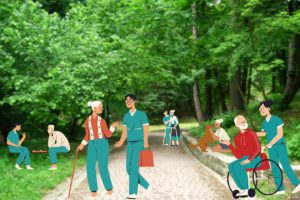Integrated Care Solutions
4 min read
Integrated Care Solutions
Aged care equipment suppliers are reshaping health outcomes by delivering adaptive tools that preserve mobility and dignity. Across Australia, at home care services weave those tools into daily routines, allowing older adults to stay safe and independent. Meanwhile, urgent care education for frontline clinicians equips them to respond confidently when conditions shift from routine to critical. Together, these three threads create a holistic fabric of support that spans the client’s entire care journey.
Dignity Through Design: The Role of Equipment
Modern assistive technology has moved far beyond the simple walking frame. Ergonomic patient‑lifting hoists reduce strain on carers while minimising pressure injuries. Adjustable beds with electronically controlled side rails prevent nighttime falls yet maintain a bedroom‑like aesthetic. Sensor‑enabled mats send silent alerts when a resident tries to stand unassisted, giving staff time to intervene before a mishap occurs. Each design choice stems from one core principle: dignity through design. When older adults feel safe and in control, they are more willing to participate in exercise plans, nutritional programs, and social activities, which collectively slow functional decline.
Personalised Support in the Home
Residential aged‑care facilities once dominated the sector, but surveys reveal that more than 80% of Australians prefer to age in place. Personal care aides, occupational therapists, and visiting nurses now coordinate services once available only in institutional settings. A weekly schedule might combine medication management on Mondays, allied health physio on Wednesdays, and a Friday social outing. Behind the scenes, cloud‑based care‑management platforms let every stakeholder—from family members to general practitioners—see real‑time notes, cutting duplicate visits and missed medications. The home becomes not merely a dwelling but an extension of the clinical ecosystem, personalised to the preferred cup of tea and the height of a kitchen bench.
Rapid Response: Training for the Unexpected
Even with sophisticated planning, health trajectories can change in minutes. A chest infection, a fall with a head strike, or an unexpected medication reaction demands immediate attention. Training programs that specialise in rapid assessment teach clinicians to distinguish between conditions that can be stabilised on-site and those requiring hospital transfer. Interactive simulations place nurses and GPs in high‑pressure scenarios—simulated hypoglycaemia and sudden delirium—where they practise decision‑making under time constraints. Because these courses are modular and often delivered online, rural practitioners earn micro‑credentials without abandoning their communities for week‑long conferences. The payoff is shorter emergency department queues and reduced patient anxiety because familiar faces remain in control.
Creating a Continuum, Not Silos
Historically, equipment vendors, community nurses, and training providers operated in separate silos, meeting only when paperwork demanded it. Integrated care dissolves those barriers. Suppose an occupational therapist notices that Mrs Davies struggle

s to transfer from bed to wheelchair despite having a mobile hoist. A quick video call with the equipment representative might reveal a better sling type, which can be dispatched the same afternoon. Simultaneously, the care plan portal flags the incident, prompting the training team to schedule a refresher session on transfer techniques for every staff member on Mrs Davies’s roster. What once took weeks of faxed forms now happens in hours, sparing the client discomfort and preventing secondary injuries.
Technology as a Silent Partner
Wearable sensors monitor gait speed and heart‑rate variability, predicting frailty progression months before it becomes clinically apparent. Bright pill dispensers eject only the correct dose at the proper time, locking between intervals and logging adherence data for pharmacists. Artificial intelligence chatbots guide family members through basic wound‑care steps at 2 a.m. when community nurses are off duty. Yet integration matters more than novelty. Devices must exchange data in interoperable formats—HL7 FHIR, for instance—so that a fall detected by a wrist sensor instantly updates the case manager’s dashboard and auto‑generates a flag for a physiotherapy review.
Economic and Ethical Imperatives
Ageing populations strain national budgets, but delayed institutionalisation can defer billions in public expenditure. More importantly, integrated models align with ethical imperatives: autonomy, beneficence, and justice. A seamless system prevents inequity in
which urban clients receive gold‑standard care while rural Australians settle for less. Government incentive schemes such as Home Care Packages can be tiered to reward providers demonstrating demonstrable coordination—shared electronic records, cross‑professional case conferences, outcome‑based reporting—rather than simply clocking billable hours.
Future‑Facing Workforce Development
By 2030, the World Health Organization predicts a global shortage of 18 million healthcare workers. Australia’s response must focus on recruitment and task‑shifting—delegating suitable clinical tasks to trained support workers equipped with decision‑support tools. Micro‑learning delivered via smartphones allows carers to upskill on the bus between appointments. Virtual‑reality scenarios familiarise them with equipment they may not have on hand, ensuring competence before encountering the real thing in a client’s lounge room.
Cultivating Resilience in Clients and Communities
While technology and training occupy headlines, psychosocial resilience ultimately determines outcomes. Community groups that pair retirees with early‑career nurses for social visits simultaneously combat loneliness and provide budding clinicians with exposure to chronic‑care realities. Intergenerational programs—grandparents teaching coding clubs, schoolchildren recording oral histories—reinforce purpose on both sides, reducing hospital admissions linked to depression and isolation. Integrated care thus extends beyond clinical metrics; it nurtures the human connections that make longevity meaningful.
Conclusion: Weaving the Threads
Integrated care solutions succeed when every actor recognises their role in a shared tapestry. Equipment suppliers innovate for safety and dignity; home‑care teams translate that innovation into daily living; and urgent‑care educators arm professionals with the skills to act decisively when the unforeseen occurs. The outcome is not merely fewer hospital beds occupied but fuller lives lived in familiar homes, surrounded by people—both loved ones and professionals—who collaborate rather than compete. In an era of demographic change, the most potent remedy may be the simple commitment to work together, ensuring that health care remains a continuum rather than a series of disconnected moments.






